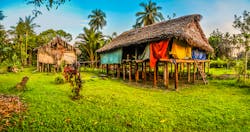USAID Invests $1.2 Million in Papua New Guinea Minigrid
The United States Agency for International Development (USAID) announced it will provide $1.2 million to establish a solar minigrid system in Papua New Guinea (PNG).
The minigrid will be located in the Oceana island nation’s Central Province, along the southern coast.
Samantha Power, USAID administrator, made the announcement during a recent trip to the region during which she also opened a USAID Country Representative Office.
The minigrid will supply reliable power to at least 4,800 people across 800 households and 30 businesses.
A land of fire, rainforests and mountains – and very little electricity
Papua New Guinea, which lies about 100 miles north of Australia in the Pacific Ocean, is home to nearly 1,000 distinct cultural groups. It is also one of the most biodiverse places on the planet with some 20,000 types of plants, 800 kinds of coral, 600 species of fish and 750 different bird varieties (including two whose feathers were recently discovered to contain a deadly neurotoxin).
Situated within the Ring of Fire, the country has 14 active and 20 dormant volcanoes, the world’s third largest rainforest, and the main island has a mountain range with peaks reaching as high as 13,000 feet.
To say the least, PNG’s diversity and topography make infrastructure projects both challenging and expensive.
As a result, it’s estimated that just 13% of the country’s 10 million residents, most of whom live in rural areas, have access to the power grid and dependable electricity.
More than just government funding
The USAID minigrid investment is part of the United States’ commitment to the Papua New Guinea Electrification Partnership (PEP) between the PNG, U.S., Australian, New Zealand and Japanese governments. PEP aims to connect 70% of the country’s population to electricity by 2030. For its part, USAID has a goal of connecting 350,000 PNG households to power by 2025.
The $1.2 million comes from USAID’s Enterprises for Development, Growth, and Empowerment (EDGE) Fund, a $50 million global fund designed to launch new partnerships that leverage private sector funds and expertise to tackle significant challenges such as climate change. USAID will provide an additional $5.2 million in humanitarian assistance to support disaster risk management and response programs and combat malnutrition.
For the PNG project, USAID is partnering with WEnergy Global, a Singapore-based clean energy company that is also working on microgrid projects in the Philippines and Indonesia. The USAID EDGE funds will be used to jump-start electrification efforts in off-grid areas.
USAID was part of a group shortlisted for a Microgrid Knowledge Greater Good Award this year for its work in Guatemala. The organization, which is the U.S. government's international humanitarian and development agency, is also active in Africa, where minigrids are widely used to power remote regions.
Stay up to date with the latest microgrid projects. Subscribe to the free Microgrid Knowledge Newsletter.
About the Author
Kathy Hitchens
Special Projects Editor
I work as a writer and special projects editor for Microgrid Knowledge. I have over 30 years of writing experience, working with a variety of companies in the renewable energy, electric vehicle and utility sector, as well as those in the entertainment, education, and financial industries. I have a BFA in Media Arts from the University of Arizona and a MBA from the University of Denver.

